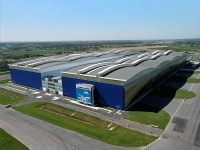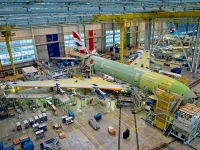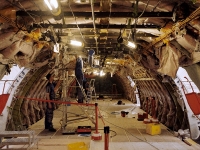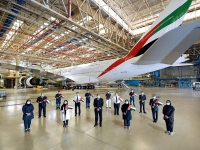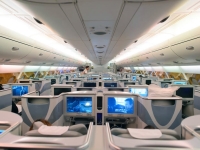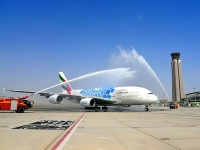News
Airbus A380 will no longer produce the Giant of the Sky
production of the A380 finished
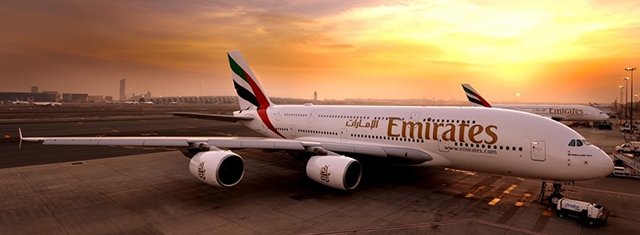
Airbus A380 (Quelle: Roberto Magni by Foto ReD Media Airbus)
The Jean-Luc Lagardère site, final assembly and preparation for flight of the A380
The Jean-Luc Lagardère site
Built between 2002 and 2004, the Jean-Luc Lagardère complex (former chairman of the Lagardère group, shareholder of Airbus Group (formerly EADS) and decisive player in the launch of the A380 program) is located in Blagnac near Toulouse.
This site, with a total surface area of 50 hectares (i.e. 2.5 times larger than the Clément Ader factory in Toulouse, where the A330s are assembled), is entirely dedicated to the final assembly and in-flight of the A380. The dimensions of the central hall are impressive:
490 meters long, 250 meters wide and 46 meters high. The site employs just over 1,000 people.
The A380 assembly process
The complete process for assembling an A380 lasts about eight months, and is carried out half in Toulouse (assembly and testing) and half in Hamburg (cabin layout and painting).
At the final assembly line in Toulouse, the industrial process follows a north-south axis. The various sub-assemblies arrive north of the Jean-Luc Lagardère site by road. Each aircraft arrives in the form of six sub-assemblies: the forward fuselage, the central fuselage, the rear fuselage, the fin and the two wings, on six towed trailers, via the wide-gauge route. The sub-assemblies are unloaded by self-propelled vehicles before being transported to the final assembly plant, which has impressive dimensions: 490 m long by 250 m wide and 46 m high.
The general assembly is done on a single combined station where all the assembly operations are carried out, with the exception of the installation of the engines. This station allows the junction of the three fuselage sections, the junction of the wings, the assembly of the horizontal and vertical tail, the installation of the engine masts, the landing gear and the wheels and the installation of the electrical cabinets. The aircraft will then be towed to the next station where the general tests will be carried out. This phase lasts about ten days.
The general tests are carried out on three modular workstations. This involves testing the electrical and hydraulic systems, the programs of the on-board computers, the moving parts, the landing gear. The reactors are also installed on these stations. This phase takes about forty days.
Outside the assembly line, the final tests are carried out (checking the calibration of the fuel gauges, the pressurization of the cabin, the radios, the radar, the navigation systems and the tightness of the tanks) and preparing the aircraft for flight. This trial phase takes about ten days.
The aircraft then performs engine tests on the run-up area, before making its first test flight by flying to Hamburg, where the commercial fitting of the cabin and the painting of the aircraft are carried out. colors of the client company. These operations last about three months (six weeks for fitting out the cabin, ten to fourteen days for painting and fourteen days for in-flight activities).
The A380s are then delivered from one of the two Airbus delivery centers in Toulouse or Hamburg.
The assembly of the largest commercial aircraft in the world currently on the market will be finished due to the steady decline in orders: a total of 313 confirmations from 13 airlines so far, with 234 aircraft already delivered.
The superjumbo A380, four engines, two floors and more than 500 passenger capacity. Up to 850 in economy-only configurations, it began flying on April 27, 2005. Officially in late October 2007, after numerous delays in the design.
The costs of making it were extremely high. Compared to the estimated 9 billion euros, and then to the 15 billion expected, the A380 program has come to cost more than 25 billion (but other evaluations bring the total to over 30 billion). The price tag of a single A380 is the highest in the industry: it costs 445 million dollars in the price list (all airliners are sold in American currency), although buyers can then count on different types of scotistics depending on the size of orders and the type of relations with the manufacturer.
The announcement of the shutdown of the A380 program does not come unexpected. It had been a while since the sky giant's development plans had stalled due to very low orders.
After the launch phase, which in any case had seen a contained enthusiasm for what the intentions of the trans-European consortium (especially Franco-German) should have been the ultimate weapon for mass transport. High operating costs, delays, but also the rising cost of fuel compared to the first years of the 21st century and the significant infrastructural costs have weighed on them.
International airports have to adapt their runways and terminals in order to manage the A380s, and not all airports worldwide have decided to do so: currently only 60 airports are capable of receiving the A380, including Fiumicino and Malpensa. In addition, China has never shown much interest.
Airbus' largest customer is Emirates, which has ordered 123 aircraft of which 109 have been delivered. The cancellation of orders from Emirates (and the Australian Qantas), the "oxygen" that kept the A380 patient alive in recent times, was the reason for the decision to cancel the program. The UAE company was the real reason the A380 was still alive, but it decided to change its strategy and move on to the competition with the new Boeing 777Xs.
weitere Informationen: https://www.redmagazine.red
Für den Artikel ist der Verfasser verantwortlich, dem auch das Urheberrecht obliegt. Redaktionelle Inhalte von GDN können auf anderen Webseiten zitiert werden, wenn das Zitat maximal 5% des Gesamt-Textes ausmacht, als solches gekennzeichnet ist und die Quelle benannt (verlinkt) wird.

